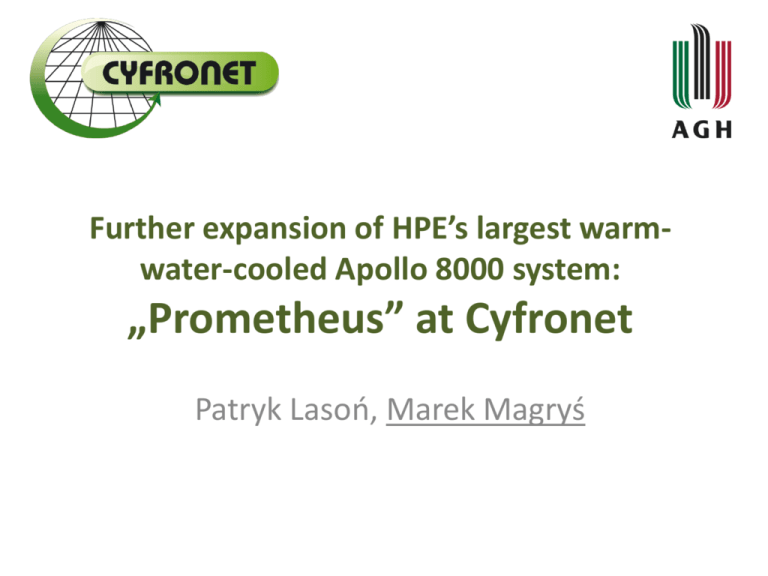ACC Cyfronet - PL-Grid
advertisement

Further expansion of HPE’s largest warmwater-cooled Apollo 8000 system: „Prometheus” at Cyfronet Patryk Lasoń, Marek Magryś ACC Cyfronet AGH-UST • established in 1973 • part of AGH University of Science and Technology in Krakow, Poland • provides free computing resources for scientific institutions • centre of competence in HPC and Grid Computing • IT service management expertise (ITIL, ISO 20k) • member of PIONIER consortium • operator of Krakow MAN • home for supercomputers PL-Grid infrastructure • Polish national IT infrastructure supporting e-Science – – – – based upon resources of most powerful academic resource centres compatible and interoperable with European Grid offering grid and cloud computing paradigms coordinated by Cyfronet • Benefits for users – unified infrastructure from 5 separate compute centres – unified access to software, compute and storage resources – non-trivial quality of service • Challenges – unified monitoring, accounting, security – create environment of cooperation rather than competition • Federation – the key to success PLGrid Core project Competence Centre in the Field of Distributed Computing Grid Infrastructures • Duration: 01.01.2014 – 31.11.2015 • Project Coordinator: Academic Computer Centre CYFRONET AGH The main objective of the project is to support the development of ACC Cyfronet AGH as a specialized competence centre in the field of distributed computing infrastructures, with particular emphasis on grid technologies, cloud computing and infrastructures supporting computations on big data. Zeus usage 7.87% chemistry physics medicine technical 44.84% astronomy biology computer science electronics, telecomunication 41.45% metalurgy mathematics other New building 5 MW, UPS + diesel Prometheus – Phase 1 • • • • • • • • Installed in Q2 2015 HP Apollo 8000 13 m2, 15 racks (3 CDU, 12 compute) 1.65 PFLOPS 1728 nodes, Intel Haswell E5-2680v3 41472 cores, 13824 per island 216 TB DDR4 RAM N+1/N+N redundancy Prometheus – Phase 2 • Installed in Q4 2015 • 4th island – 432 regular nodes (2 CPUs, 128 GB RAM) – 72 nodes with GPGPUs (2x NVIDIA Tesla K40 XL) • 2.4 PFLOPS total performance (Rpeak) – 2140 TFLOPS in CPUs – 256 TFLOPS in GPUs • 2232 nodes, 53568 CPU cores, 279 TB RAM • <850 kW power (including cooling) Prometheus storage • Diskless compute nodes • Separate procurment for storage – Lustre on top of DDN hardware – Two filesystems: • Scratch: 120 GB/s, 5 PB usable space • Archive: 60 GB/s, 5 PB usable space – HSM-ready • NFS for home directories and software Prometheus: IB farbic Core IB switches 576 CPU nodes 576 CPU nodes 576 CPU nodes Compute isle Compute isle Compute isle 432 CPU nodes 72 GPU nodes Compute isle services nodes storage nodes Service isle Why liquid cooling? • Water: up to 1000x more efficient heat exchange than air • Less energy needed to move the coolant • Hardware (CPUs, DIMMs) can handle ~80 C • Challenge: cool 100% of HW with liquid – network switches – PSUs What about MTBF? • The less movement the better – pumps – fans – HDDs • Example – pump MTBF: 50 000 h – fan MTBF: 50 000 h – 2300 node system MTBF: ~5 h Why Apollo 8000? • Most energy efficient • The only solution with 100% warm water cooling • Highest density • Lowest TCO Even more Apollo • Focuses also on ‘1’ in PUE! – Power distribution – Less fans – Detailed monitoring • ‘energy to solution’ • • • • Dry node maintenance Less cables Prefabricated piping Simplified management Secondary loop System software • CentOS 7 • Boot to RAM over IB, image distribution with HTTP – Whole machine boots up in 10 minutes with just 1 boot server • Hostname/IP generator based on MAC collector – Data automatically collected from APM and iLO • Graphical monitoring of power, temperature and network traffic – SNMP data source, – GUI allows easy problem location – Now synced with SLURM • Spectacular iLO LED blinking system developed for the official launch HPL: power usage HPL: water temperature Real application performance • Prometheus vs. Zeus in theory 4x difference core to core • Storage system (scratch) 10x faster • More time to focus on the most popular codes • • • • COSMOS++ – 4.4x Quantum Espresso – 5.6x ADF – 6x Widely used QC code with the name derrived from a famous mathematician – 2x Future plans • • • • • • Continue to move users from the previous system Add a few large-memory nodes Further improvements of the monitoring tools Detailed energy and temperature monitoring Energy-aware scheduling Collect the annual energy and PUE








